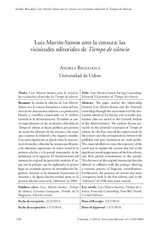Luis Martín-Santos ante la censura: las vicisitudes editoriales de Tiempo de silencio
Luis Martín-Santos Facing Censorship: Editorial Vicissitudes of Tiempo de silencio
Autor
Bresadola, Andrea
Editor
Universidad de Córdoba, Departamento de Literatura EspañolaFecha
2014Materia
Martín-Santos, LuisTiempo de silencio
Censura franquista
Francoist censorship
Novela de posguerra
Post-War novel
Edición crítica
Critical edition
METS:
Mostrar el registro METSPREMIS:
Mostrar el registro PREMISMetadatos
Mostrar el registro completo del ítemResumen
Se estudia la relación de Luis Martín-
Santos con la censura franquista a través del examen
de los documentos relativos a su producción
literaria y científica conservados en el Archivo
General de la Administración. El análisis se centra
especialmente en las vicisitudes editoriales de
Tiempo de silencio: se hacen públicos por primera
vez todos los informes de los censores y las cartas
que cruzaron la editorial y los órganos estatales.
Con estos expedientes se puede trazar la trayectoria
de la novela y dilucidar las razones que llevaron
a las relevantes supresiones de orden moral de la
primera edición y a la parcial restauración de las
tachaduras en la segunda. El descubrimiento del
manuscrito original ha permitido también el cotejo
con la princeps, que ha explicitado en primer
lugar un constante proceso de normalización lingüística.
Además, se ha destacado la presencia de
variantes y de alguna lección errónea tanto en la
primera edición como en la “definitiva” de 1980 The paper studies the relationship
between Luis Martín-Santos and the Francoist
censorship through the examination of the documents
related to his literary and scientific production
that are stored at the General Archive
of the Administration. The analysis focuses primarily
on the editorial vicissitudes of Tiempo de
silencio: for the first time all the reports made by
the censors and the correspondence between the
publisher and state institutions are made public.
This material allows to trace the trajectory of the
novel and to explain the reasons that led to the
significant moral suppressions of the first edition,
and their partial reinstatement in the second.
The discovery of the original manuscript has also
allowed its collation with the princeps, showing
a constant process of linguistic normalization.
Furthermore, the presence of variants and some
corruptions both in the first edition, and in the
“definitive” of 1980, have been noticed.

